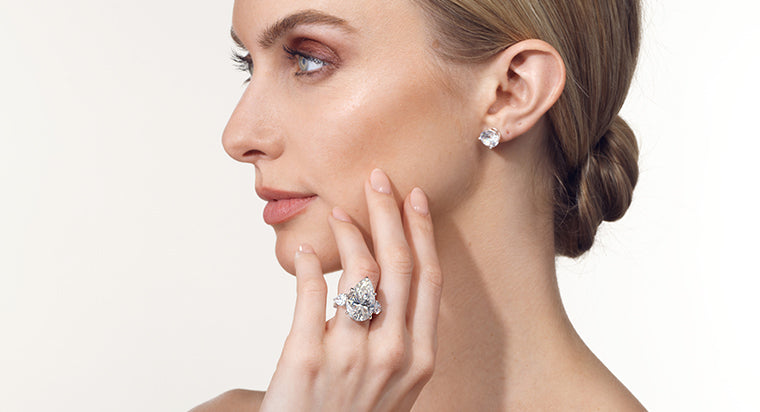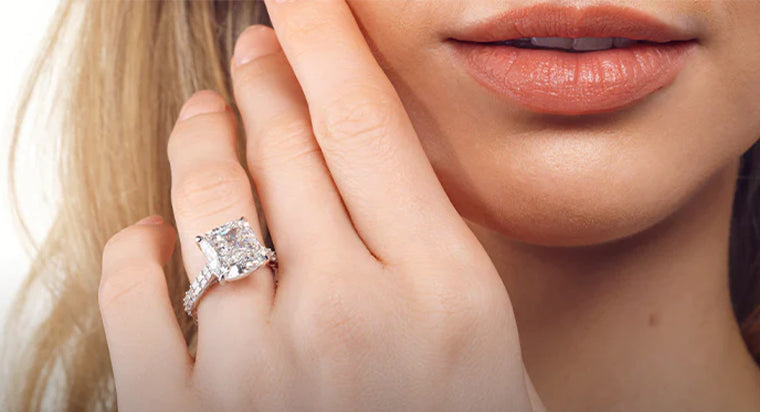Buying Guide for Three-Stone Diamond Engagement Rings

Let’s be real: No other style captures romance and symbolism quite like a three-stone engagement ring. It’s elegant, meaningful, and designed to sparkle from every angle. With each stone representing your past, present, and future, this classic design tells a story of a love that endures. So it’s no wonder more and more couples are falling for its charm.
If you’re thinking about a three-stone ring, then you’re in the right place. In this guide, we’ll walk you through everything you need to know—from choosing the perfect setting and metal to budgeting wisely—so you can find a ring that’s just as unforgettable as your love story.
TABLE OF CONTENTS
Why Choose a Three-Stone Diamond Engagement Ring?
The three-stone engagement ring, also called a trilogy ring, is a design steeped in symbolism. Each diamond tells a chapter of your love story. The first sparkles with memories of how you met and fell in love. The center stone celebrates your life together now—your bond, your commitment. And the third looks ahead, symbolizing the future you're building and all the milestones still to come.
Three-Stone Diamond Engagement Rings: A Coveted Choice
Wondering if trilogy engagement rings are a smart buy today? Then let us tell you, although they may have an old-school charm, they’re topping the trend charts in 2025.
Jewelers and bridal experts reported a renewed interest in this setting, with couples drawn to its balance of romance, symbolism, and striking visual impact.
Modern brides and grooms are adding their own twist to the classic design by experimenting with different diamond shapes—think round, pear, emerald, or oval—and playing with creative combinations of vintage and contemporary elements. From sleek minimalist settings to ornate Art Deco-inspired designs, the three-stone ring offers endless opportunities for personalization while keeping its deep emotional meaning at the heart of the design.
Three Stone Engagement Rings: The Pros & Cons
A three-stone engagement ring offers more than just sparkle—it tells a meaningful story. The design is highly customizable, allowing you to mix and match diamond shapes, sizes, and settings to create a ring that feels entirely personal. Side stones not only add character but also amplify the visual impact, making the entire ring appear larger and more striking. They naturally draw attention to the center diamond, enhancing its brilliance and presence on the finger. Whether you lean toward the ornate charm of vintage styles or the clean lines of modern minimalism, the three-stone design adapts effortlessly, making it a timeless option for a wide range of tastes.
However, more diamonds also mean a higher price tag. Three-stone engagement rings typically cost more than classic solitaires. But don’t let that dim your dream. With lab-grown diamonds, you can get the stunning three-stone ring you’ve been eyeing without stretching your budget… (more on that later.)
Who Should Say Yes to a Three-Stone Ring?
To sum up, if you love jewelry with meaning, crave a little extra sparkle, and want an elaborate ring, the three-stone ring would be your perfect match. It’s ideal for romantics who appreciate symbolism, or anyone who wants a standout engagement ring with a story.
So, are you ready to shop for the three-stone engagement ring of your dreams? Then here’s what to look out for!
Three-Stone Diamond Engagement Rings: The Buying Guide
1. Picking Between Natural & Lab-Grown Diamonds
Trinity rings have three diamonds, which means an increased cost.
Yep, if you’re going the traditional route with natural diamonds, expect to spend anywhere from $5,000 to $10,000 or more, depending on the size and quality of the stones.
But don’t panic…One of the easiest ways to cut down on this is by opting for lab diamonds. To help you understand, let’s take a look at two three-stone rings, one with natural diamonds and the other with lab-grown stones.
Both rings have the same specifications: they feature a central diamond of 2 CT, of G Color, VS1 Clarity. Yet the price difference is massive!

The one with natural diamonds costs approximately $30,000, whereas the lab-grown version of this ring costs less than $3500. Now that’s over $25,000 in savings—without compromising on brilliance, durability, or design.
2. Popular Diamond Shapes
One of the best things about three-stone engagement rings? They look stunning with just about any diamond shape.
Round center stone is a timeless favorite—it offers unmatched brilliance and pairs beautifully with side stones in complementary shapes like pears or baguettes.
But if you're after something a little different, try fancy-shaped diamonds:
For a distinctive look, consider elongated ovals with half-moon and pear-cut diamonds. A sleek emerald-cut with its hall-of-mirrors sparkle shines alongside trapezoid or round-cut diamonds.
Marquise and pear shapes naturally create a tapered look and look stunning when teamed with complementary stones and baguettes.
PS: These were just some of the most popular combinations; you can even mix, match, and create a ring with whatever shape you want.
3. Ideal Settings for Three-Stone Rings
While the three diamonds remain consistent, the overall look of the ring depends on how it’s set. Here are a few popular options:
- Classic Prong Setting: Each stone is secured with prongs, letting in plenty of light for maximum sparkle.
- Trellis Setting: The diamonds are held in a graceful, intertwining metal design—elegant and romantic.
- Bezel Setting: For a modern, sleek look and added protection, each diamond is encased in metal.
- Three-stone halo: If you want to dial up the glam, consider three-stone halo rings. In this style, each stone is encircled by a shimmering halo of diamonds, amplifying brilliance and adding irresistible sparkle from every angle.
Metal Choices & Pairing Tips
Three-stone engagement rings work well with all types of metals. Platinum and gold (white, yellow, and rose) look stunning when teamed with white diamonds.
While choosing metals, do think ahead about how you plan to wear your sparkler: Do you want to wear it every day? Do you want to wear it with a wedding band? Should the metals of both pieces match and have a cohesive look, or are you okay with a unique bridal stack?
Diamond Buying Tips
There are some tips and tricks you can keep in mind as you shop for three-stone rings:
- Cut is everything. It’s what gives a diamond its signature sparkle—the kind that catches the light (and everyone’s attention) from across the room. Choose an excellent or ideal cut for maximum brilliance.
- Aim for G–H color and VS1–VS2 clarity for a bright, eye-clean look without overspending.
- Keep side stones about one-quarter to one-half the size of the center for perfect balance.
- Consider a center stone just under a milestone weight (like 0.90 carat instead of 1.0 carat)—you’ll save money, and the size difference is barely noticeable. Because a three-stone ring already brings more sparkle with the side stones, you can get a stunning look without needing a huge center diamond.
- When browsing for engagement rings online, look for reputable jewelers and do your research. Take a close look at company policies (warranty, return policies, customer service) and read customer reviews.
Caring for Your Three-Stone Engagement Ring
To keep your three-stone engagement ring sparkling, clean it regularly with a soft brush, mild soap, and warm water. It removes any dirt and grime, making the diamonds look new again. Avoid wearing it while doing heavy work or using harsh chemicals. And don’t forget—an annual professional cleaning and prong check will help keep those diamonds secure and shining bright!
Conclusion
Three-stone engagement rings combine meaning, style, and brilliance in one unforgettable design. Choose diamonds that fit your taste and budget. The ring will be beautiful and symbolic, representing your journey together. Whether you stick with the same-shaped stones or mix up the shapes, a three-stone ring is a meaningful and stunning choice.
FAQs
Are three-stone engagement rings more expensive than solitaires?
Is the center stone in a three-stone ring always bigger than the side stones?
What are the best shapes for three-stone rings?
How can I tell if a lab diamond is high quality?
Can I customize a three-stone diamond engagement ring?









